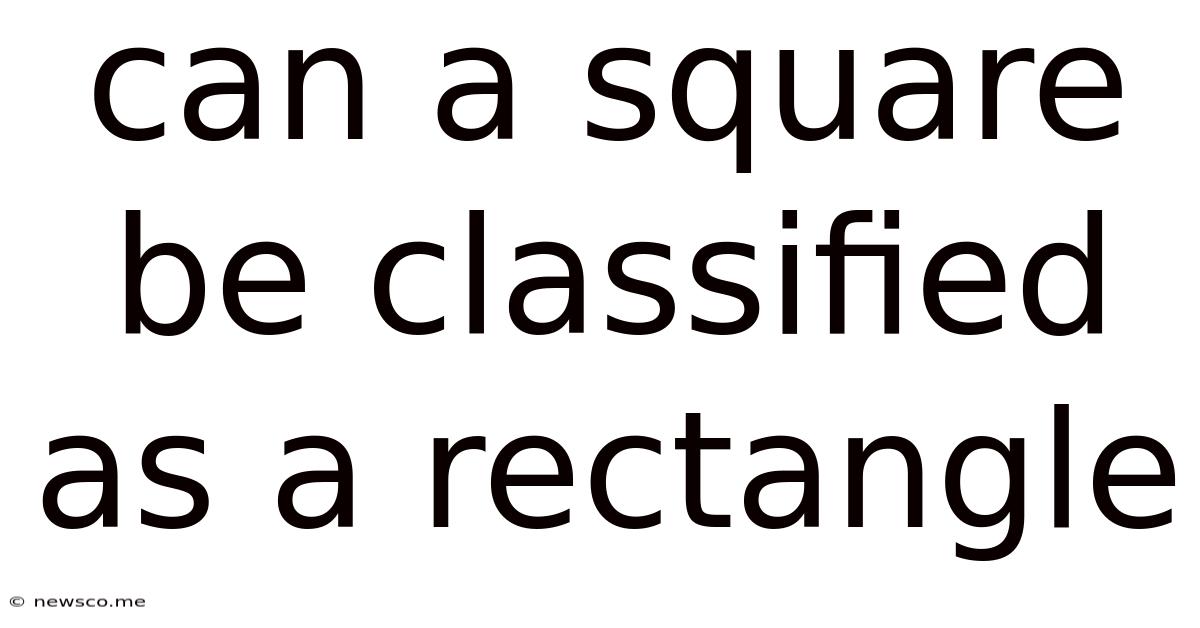Can A Square Be Classified As A Rectangle
News Co
Apr 19, 2025 · 4 min read

Table of Contents
Can a Square Be Classified as a Rectangle? A Deep Dive into Geometric Classification
The question, "Can a square be classified as a rectangle?" might seem deceptively simple. At first glance, the answer appears obvious. However, a deeper exploration reveals a fascinating interplay between definitions, properties, and the hierarchical nature of geometric classifications. This article will delve into the specifics, exploring the defining characteristics of both squares and rectangles, and ultimately answering the central question definitively. We'll also touch upon the broader implications for understanding geometric relationships and the importance of precise definitions in mathematics.
Understanding the Definitions: Square vs. Rectangle
Before we can determine the relationship between squares and rectangles, we need precise definitions for each shape. These definitions are crucial for establishing the hierarchical classification within geometry.
The Rectangle: A Definition
A rectangle is defined as a quadrilateral (a four-sided polygon) with four right angles (90-degree angles). This definition is fundamental. It doesn't specify anything about the lengths of the sides. Crucially, a rectangle only requires the presence of four right angles; the lengths of its sides are not restricted. This opens the door for a range of possibilities, including squares.
Key Properties of a Rectangle:
- Four sides: The fundamental characteristic of any quadrilateral.
- Four right angles: This is the defining property distinguishing rectangles from other quadrilaterals.
- Opposite sides are parallel and equal in length: A consequence of having four right angles.
- Diagonals bisect each other: The diagonals of a rectangle intersect at their midpoints.
The Square: A Definition
A square is defined as a quadrilateral with four equal sides and four right angles. This definition is more specific than that of a rectangle. A square incorporates all the properties of a rectangle, but adds the additional constraint of equal side lengths. This means that a square is a more specialized type of rectangle.
The Hierarchical Relationship: Squares as a Subset of Rectangles
The definitions clearly establish a hierarchical relationship. Because a square possesses all the properties of a rectangle (four right angles), it can be considered a special case, or a subset, of rectangles. It's like saying all apples are fruits, but not all fruits are apples. All squares are rectangles, but not all rectangles are squares.
This relationship is often visualized using Venn diagrams. The rectangle set would encompass a larger area, while the square set would be a smaller circle entirely contained within the rectangle set. This visually represents the inclusive nature of the classification.
Exploring the Implications: Why This Matters
Understanding the hierarchical relationship between squares and rectangles is not merely an academic exercise. It has significant implications in various fields:
- Computer Graphics and Programming: In programming, knowing that a square is a type of rectangle allows for more efficient code. Functions designed to work with rectangles can also handle squares without needing separate, specialized code.
- Engineering and Construction: In structural engineering and construction, the properties of both rectangles and squares are crucial for calculating stress, strain, and stability. Understanding their relationship ensures correct application of formulas and principles.
- Mathematics Education: Recognizing the hierarchical nature of geometric shapes helps students grasp fundamental mathematical concepts more effectively, fostering a deeper understanding of geometric principles and relationships.
Addressing Common Misconceptions
Sometimes, the subtle distinction between squares and rectangles is overlooked, leading to misconceptions.
- Confusing necessary and sufficient conditions: While four right angles are necessary for a shape to be a rectangle, they are not sufficient to define a square. Equal side lengths are also necessary for a shape to be classified as a square.
- Overemphasis on visual appearance: Simply looking at a shape might be misleading. Precise definitions based on angles and side lengths are crucial for accurate classification.
Beyond Squares and Rectangles: Further Exploration of Geometric Classifications
The relationship between squares and rectangles provides a gateway to understanding more complex geometric classifications. This hierarchical approach extends to other shapes:
- Parallelograms: Rectangles are a specific type of parallelogram, characterized by having four right angles. Parallelograms, in turn, are quadrilaterals with opposite sides parallel.
- Rhombi: A rhombus is a quadrilateral with all four sides equal in length. Squares are a specific type of rhombus with four right angles.
Conclusion: The Definitive Answer
To answer the initial question, definitively: Yes, a square can be classified as a rectangle. A square satisfies all the requirements of a rectangle (four right angles), plus the additional requirement of equal side lengths. This hierarchical classification is fundamental to understanding geometry and has significant implications in various fields. By precisely defining geometric shapes and understanding their relationships, we can build a stronger foundation for mathematical reasoning and practical applications. This precise classification ensures consistency and clarity in mathematical discourse and problem-solving across various disciplines. The seemingly simple question about the relationship between squares and rectangles opens a world of understanding regarding the precise definition of shapes and their hierarchical classification within the broad field of geometry.
Latest Posts
Related Post
Thank you for visiting our website which covers about Can A Square Be Classified As A Rectangle . We hope the information provided has been useful to you. Feel free to contact us if you have any questions or need further assistance. See you next time and don't miss to bookmark.